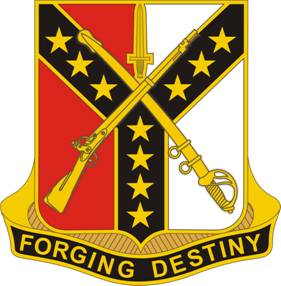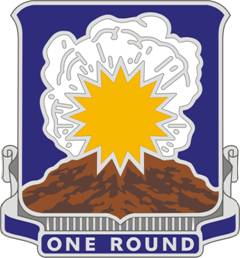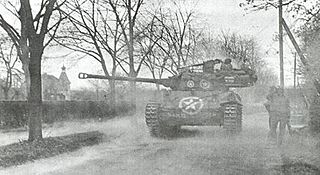
The M10 tank destroyer was an American tank destroyer of World War II. After US entry into World War II and the formation of the Tank Destroyer Force, a suitable vehicle was needed to equip the new battalions. By November 1941, the Army requested a vehicle with a gun in a fully rotating turret after other interim models were criticized for being too poorly designed. The prototype of the M10 was conceived in early 1942 and delivered in April that year. After appropriate changes to the hull and turret were made, the modified version was selected for production in June 1942 as the 3-inch Gun Motor Carriage M10. It mounted a 3-inch gun M7 in a rotating turret on a modified M4 Sherman tank chassis. An alternate model, the M10A1, which used the M4A3 variant chassis, was also produced. Production of the two models ran from September 1942 to December 1943 and October 1942 to November 1943, respectively.

The 3-inch gun M5 was an anti-tank gun developed in the United States during World War II. The gun combined a 3-inch (76.2 mm) barrel of the anti-aircraft gun T9 and elements of the 105 mm howitzer M2. The M5 was issued exclusively to the US Army tank destroyer battalions starting in 1943. It saw combat in the Italian Campaign and on the Western Front in Northwest Europe.

The tank destroyer battalion was a type of military unit used by the United States Army during World War II. The unit was organized in one of two different forms—a towed battalion equipped with anti-tank guns, or a mechanized battalion equipped with armored self-propelled guns. The tank destroyer units were formed in response to the German use of massed formations of armored vehicles units early in WWII. The tank destroyer concept envisioned the battalions acting as independent units that would respond at high speed to large enemy tank attacks. In this role, they would be attached in groups or brigades to corps or armies. In practice, they were usually individually attached to infantry divisions. Over one hundred battalions were formed, of which more than half saw combat service. The force was disbanded shortly after the end of the war when the concept had been shown to be militarily unsound.

The 601st Tank Destroyer Battalion was a battalion of the United States Army active during World War II. It was the first of the newly formed tank destroyer battalions to see combat, and the only one to fight as a "pure" tank destroyer force. It also has the unusual distinction of being one of the few American units to fight in all three major campaigns against Nazi Germany and to have participated in four assault landings.

The 602nd Tank Destroyer Battalion was a tank destroyer battalion of the United States Army active during the Second World War.
The 614th Tank Destroyer Battalion was a tank destroyer battalion of the United States Army active during the Second World War. The unit was activated in 1942 and trained through the late summer of 1944. Arriving on the Normandy coast in October, they moved to the Metz, France, area, seeing their first action in late November. In early December, they were attached to the 103rd Infantry Division, a pairing that was to last through the end of combat in Europe. The 3rd Platoon, Company C, of the 614th was the first African-American unit to receive a Distinguished Unit Citation during World War II. They received credit for the Northern France, Rhineland, Ardennes-Alsace and Central Europe campaigns.
The 607th Tank Destroyer Battalion was a tank destroyer battalion of the United States Army active during the Second World War. They arrived in England during April, 1944, and entered combat in mid June, landing at Utah Beach. The unit fought across France and into Germany during the summer and early winter of 1944. In late winter, they were then pulled out and sent to Belgium near the end of the Ardennes Campaign and again fought their way into and across Germany, ending the war near the Czechoslovakian border. The 607th received credit for the Normandy, Northern France, Rhineland, Ardennes-Alsace and Central Europe campaigns.

The 818th Tank Destroyer Battalion was a tank destroyer battalion of the United States Army active during World War II. It first saw combat in July 1944, when it deployed into the Normandy beachhead in preparation for the breakout into France by Lieutenant General George Patton's Third Army. Working closely with the 5th Infantry Division, it moved through northern France up to the Moselle region, where it was involved in the Battle for Metz through September, October and November. In December, it disengaged from defensive positions along the German border and was moved north to fight in the Battle of the Bulge with the 26th Infantry Division. After securing the Allied flanks and mopping up the Bulge, it refitted for two months before fighting south along the Siegfried Line and crossing the Rhine in March. In April and early May, it rushed through southern Germany into Austria and Czechoslovakia, where it ended the war. After a brief spell of occupation duties, it was returned to the United States and disbanded in November. During the European campaign, the battalion lost a total twenty-six men and eight tank destroyers in combat.

The 809th Tank Destroyer Battalion was a tank destroyer battalion of the United States Army active during the Second World War.
The 773rd Tank Destroyer Battalion was a tank destroyer battalion of the United States Army active during the Second World War.
The 628th Tank Destroyer Battalion was a tank destroyer battalion of the United States Army active during the Second World War. It was redesignated the 628th Tank Battalion after the end of the war, and today exists as the 103rd Armor Regiment.

The 808th Tank Destroyer Battalion was a tank destroyer battalion of the United States Army active during the Second World War.

The 643rd Tank Destroyer Battalion was a tank destroyer battalion of the United States Army active during the Second World War.
The 631st Tank Destroyer Battalion was a tank destroyer battalion of the United States Army active during the Second World War.

The 633rd Tank Destroyer Battalion was a self-propelled tank destroyer battalion of the United States Army active during the Second World War.

The 705th Tank Destroyer Battalion was a tank destroyer battalion of the United States Army active during the Second World War. It was originally formed from artillery elements of the 5th Armored Division, and its lineage is today perpetuated by the 75th Cavalry Regiment.
The 827th Tank Destroyer Battalion was a tank destroyer battalion of the United States Army active during the Second World War. It was activated in April 1942 as a segregated African American unit, deploying to Europe at the end of 1944 and attached to 12th Armored Division. It saw action during Operation Nordwind in January 1945, where elements of the battalion performed creditably. However, its overall combat record was marred by severe disciplinary problems and insufficient training. It was withdrawn in February, and assigned to rear-area duties; while it nominally remained active for the remainder of the war, it had been effectively disbanded.
The 825th Tank Destroyer Battalion was a tank destroyer battalion of the United States Army active during the Second World War. It was organized as a towed battalion, with 3" anti-tank guns, and initially saw service during the Battle of Normandy as a rear-area security unit. Parts of the unit were sent into combat as part of an ad hoc task force on 16 December 1944, on the northern flank of the Ardennes Offensive, where it defended Amblève river bridges at Malmedy and Stavelot. It returned to security duties at the end of January 1945, and served in rear areas for the remainder of the war.

The 648th Tank Destroyer Battalion was a tank destroyer battalion of the United States Army active during the Second World War.

The 824th Tank Destroyer Battalion was a tank destroyer battalion of the United States Army active during the Second World War. It saw service during 1944–45 in the European Theater of Operations, primarily attached to the 100th Infantry Division in an infantry support role. After fighting through France and southern Germany, the battalion ended the war in Austria.









